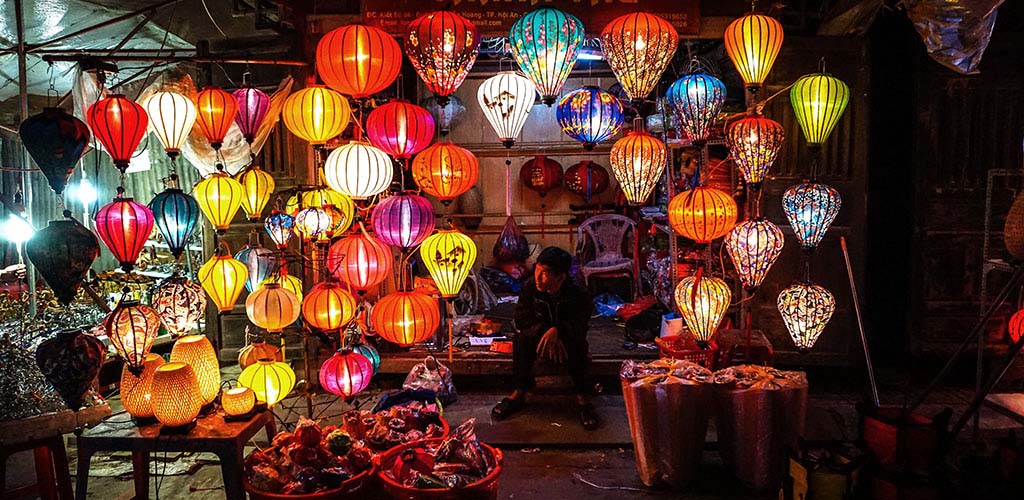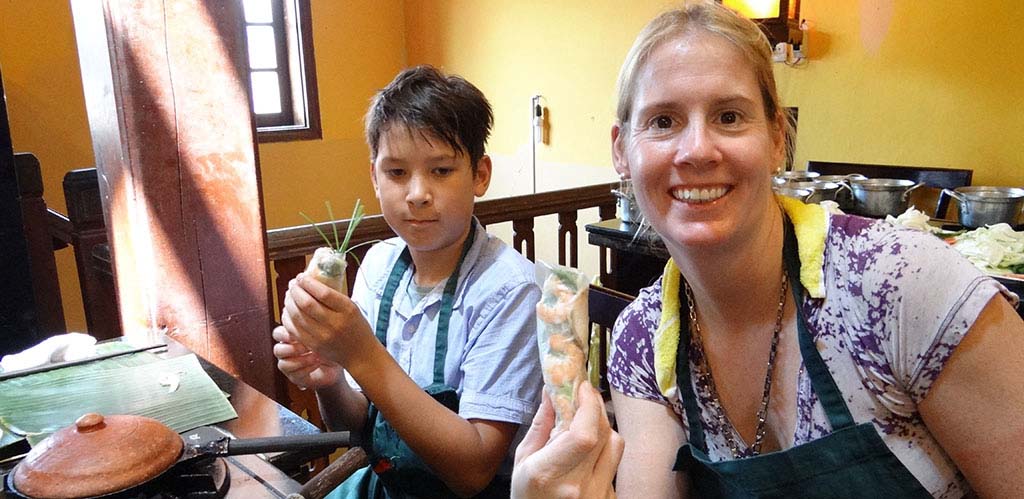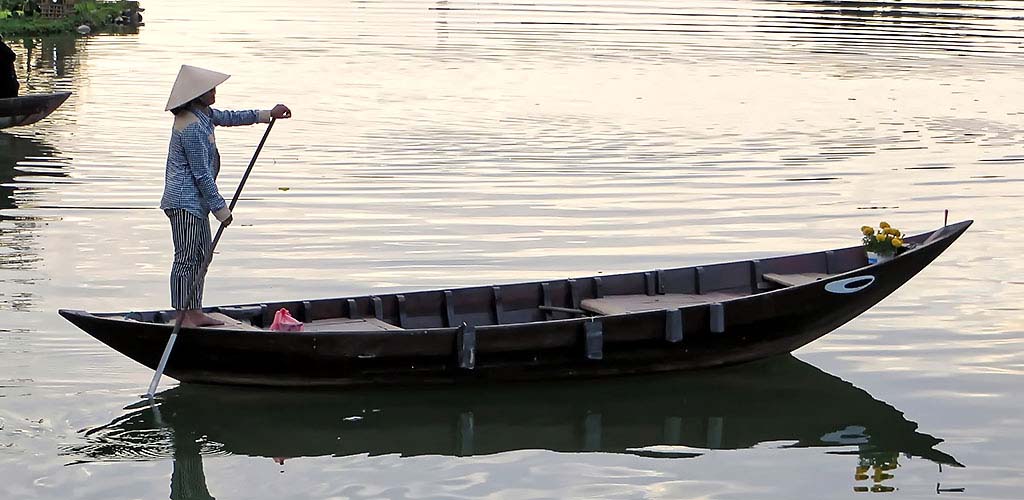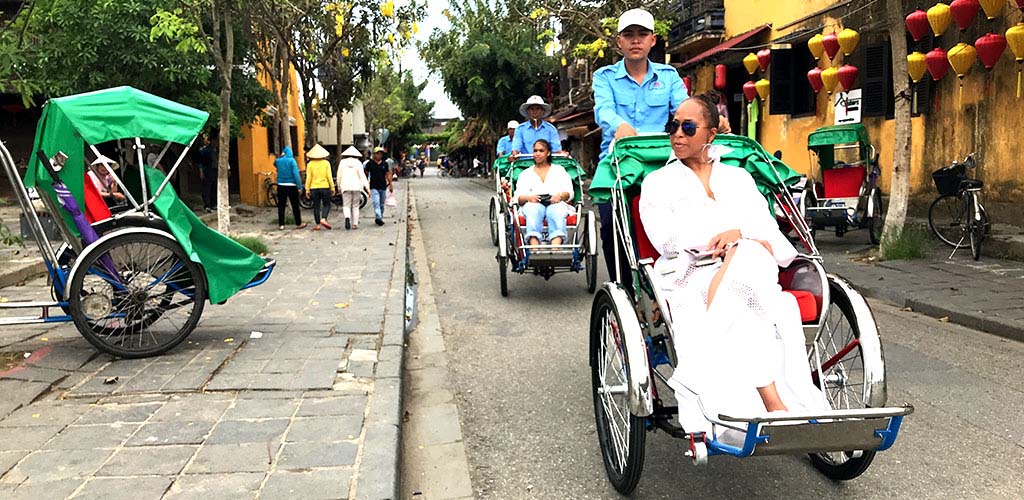A small jewel on the central coast, Hoi An is an quaint, ancient port town on the tranquil Thu Bon River, just three miles inland from white sand beaches fronting the South China Sea. In time past, it was an important trading port between China, Japan, and Portugal, before silting up and influence ebbed. For over a hundred years the small lie dormant unoticed, even passed over by the Vietnam war. Over the last two decades, it has again become bustling with life, attracting travelers in its uniquely charming way. In 1999, Hoi An became a UNESCO World Heritage Site for its efforts. The pleasant Old Quarter now features stylish boutique hotels, cafes, world-famous restaurants, tailoring shops, and galleries. Come discover why Hoi An is typically everyone's favorite stop in Vietnam.
Hoi An is the quintessential Vietnamese town of the imagination, with an idyllic riverfront location, ochre-colored French buildings, towering palms, busy with conical-hat wearing locals. Standout cuisine and small town vibe have made it a favorite for travelers. Despite success, the town for the most part has grown its tourist trade tastefully and even rationally, closing off the central area to motorized traffic (no small feat in Asia as you will witness in Hanoi and Saigon). Hoi An is a rare place in Vietnam where you'll find genuine Vietnamese architecture. The Old Quarter, though heavily influenced by Chinese and lined with French row houses, still has vestiges of native architecture which survived the American war untouched though aged by periodic flooding which may rise up over the first floors some years.

Indochina Travel's Hoi An Favorites
- Walking — Hoi An is Vietnam's most walkable town.
- Sunrise at the central market, a busy time when fisher-folk return from all night fishing on the South China Sea. The setting is unforgettable by morning light, an ideal time for photography.
- Cafes. Hoi An enjoys Vietnam's most refined and picturesque small town setting, with plenty of small, pleasant cafes to drink it all in. Though popular with tourists, there's much authentic here, such as older men playing Chinese checkers by candlelight.
- The Nam Hai. Indochina's premier beach resort is truly a one-of-a-kind stunner. Highly recommended during the warmer seasons.
- Cuisine. Hoi An is flush with talented chefs, including our old friend Miss Vy who runs a rigorous yet delightful cooking class. The dining scene is always changing so ask us for our latest recommendations.
- Cycling. Lets load our bikes onto a boat and cruise up the Thu Bon river for biking through the farms and scenic countryside outside of town.
- Flash Fashion. Have your favorite article of clothing duplicated in 24-hours, ot be fitted for a fashionable Ao Dai, the colorful Vietnamese traditional dress.

Hoi An Architour
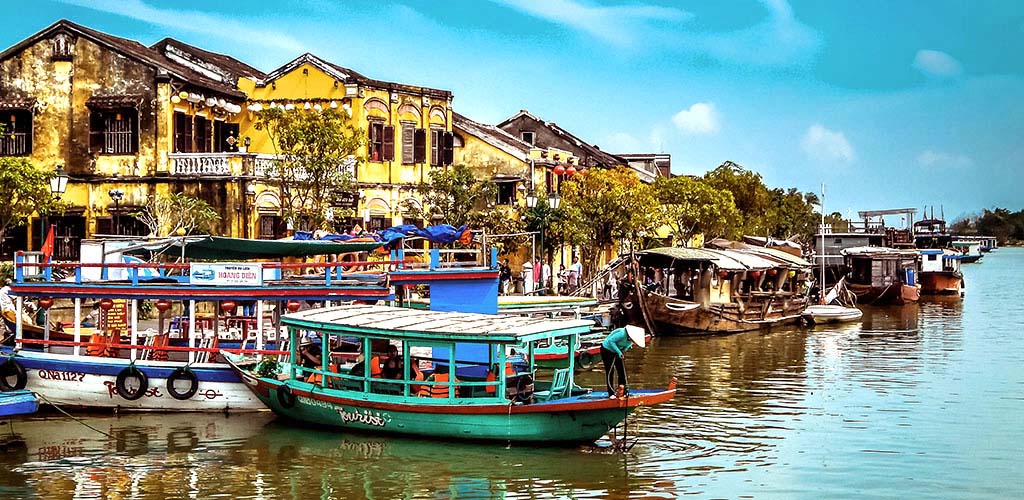
A highlight of smaller Hoi An is it's well-preserved French-era architecture which can be taken in during a stroll around the town. Along Tran Phu you'll see moss-covered roofs, some concrete buildings, and some French-style buildings with shutters. There are half a dozen houses in Hoi An recognized as heritage pieces which were even issued certificates to prove it. Although repaired and remodeled, these houses retain their original character, family heirlooms, and furniture, and often the original family.
Start our architour by dropping in at Quan Thang House at 77 Tran Phu for a cup of tea we'll be shown around (and may talked into buying souvenirs). Half-a-dozen family members live here now; on the wall hangs a portrait of the great-great-grandfather, a Chinese merchant and traditional medicine practitioner. The house is some 300 years old, but of course wood doesn't last that long and it's been replaced gradually. Wooden pillars are ingeniously mounted on marble bases to prevent rotting; ornate woodwork features dragons or unicorns on finials.
In 2000, Hoi An revived an old custom called the Night Festival, taking place around the 14th day of each lunar month (the time of a full moon). For this event-scheduled for early evening, Hoi An reverts for one night to the way it looked 600 years ago. No motor traffic is permitted; televisions are turned off. Residents cut fluorescent lights, illumination is provided by silk and paper lanterns hung from buildings. Events are staged on street corners in the Old Quarter by Hoianese in traditional dress; music and poetry recitals, games of Chinese chess. So the town appears to be the set for a Chinese historical drama-its narrow streets festooned with lanterns glowing red or yellow-hanging from restaurants and shops, reflected in the water near riverside cafes.
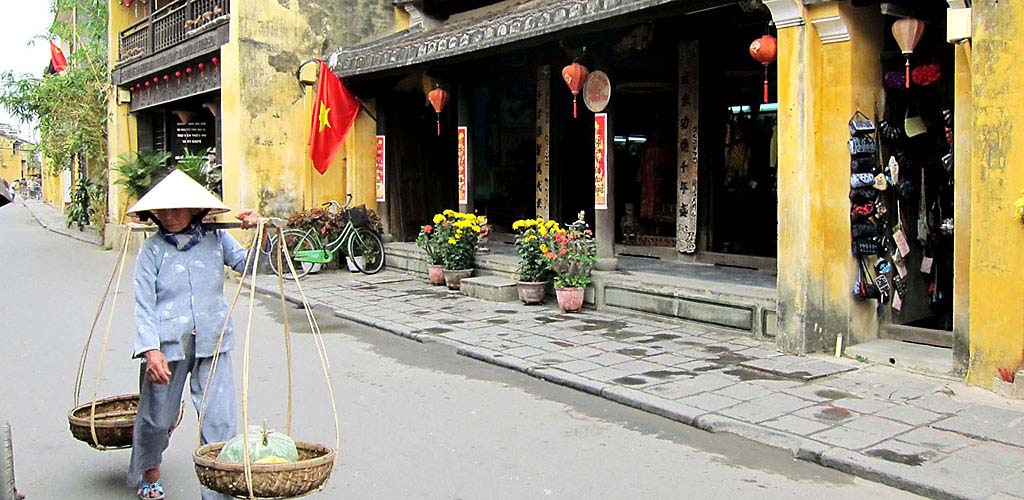
On Nguyen Thai Hoc, next door to number 80, we'll find another classic, Diep Dong Nguyen House. Diep Dong Nguyen is marked on the building; a lattice doorway and bold calligraphy on the exterior. Diep Dong Nguyen House was once a dispensary for Chinese medicine. This place doesn't seem keen on visitors, but if we get past the door, the interior features antique furniture, porcelain, and lanterns. Tan Ky House, 101 Nguyen Thai Hoc, features Chinese and Japanese influences in its structure. Visitors welcome. This elongated house has a shop front entrance on Nguyen Thai Hoc Street, and a storage and dock entrance in back on Bach Dang Street. The interior living quarters are grouped around an open courtyard. There are three kinds of timber in the 200-year-old structure-timber from the jack fruit tree poses a problem as it at-tracts termites. Fine carvings decorate the woodwork; some are inlaid with mother-of-pearl. The Japanese Covered Bridge is a Hoi An landmark. The curved bridge has a green and yellow tile roof, two guardian dogs on the east side, and two guardian monkeys to the west side. The bridge is vintage 16th century, most likely constructed by the Japanese community to link the Chinese quarter with the Japanese quarter. A small Japanese-style pagoda that protects sailors is built into the north side of the bridge. The chapel is normally locked but we can get in if we buy a ticket, there's not a lot to see
Over the Japanese Covered Bridge is Phung Hung House, at 4 Nguyen Thi Minh Khai St., the mansion of the Phung Hung family for eight generations. The wooden structure has elements of Vietnamese, Chinese, and Japanese styles, constructed using 80 columns of ironwood with marble bases. The structure is held in place with large wooden nails. The four-sided roof is made of Yin and Yang tiles, named after the way the tiles lock together. Another interesting feature of the house is a flood provision: a square opening on the ceiling allows hauling of belongings to the second floor. The last major flood hit Hoi An in 2007. The Phung Hung family welcome tourists, and sell souvenirs from a boutique at the front. In the same area, on both sides of the bridge but especially on the west side, other shops sell silk, art, souvenirs, and marble carvings. There's also an art gallery in a French two-story building near the bridge.
A short way east of the Japanese Covered Bridge is Quang Dong Pagoda, or the Assembly Hall for Maritime Commerce. This pagoda was open to all Chinese traders or seamen, and is dedicated to Thien Hau. It's a small Chinese-style temple, with a lintel-gate, a rocky courtyard, and lucky animals depicted in statuary-a lion and a phoenix mounted on turtles, and dragon coiled columns inside. Strolling eastward along Tran Phu we'll come across some ancient buildings formerly used for cotton mills, weaving workshops, or furniture making, and now adapted for other uses.
Our last stop is for tea: the Tran Family Chapel, near the corner of Phan Chu Trinh, is entered from Le Loi Street. The ancestral chapel is maintained by eight members of the Tran family, who live in the house nearby. The Tran family is seeking funds for renovation of the chapel, which is 200 years old, and was last restored in the 1930s after a fire. With some houses occupied continuously for seven generations, ancestor worship is ubiquitous in Hoi An. The altar holds wooden boxes containing the tablets of Tran family ancestors arranged in order from oldest to newest generations, with Chinese characters chiseled in the tablets to summarize their curricula vitae. The annual gathering of the Tran clan in December draws up to 100 relatives.

Arts, Crafts & Tailoring
Crafts Crawl
Hoi An offers a variety of sophisticated crafts, design and fashion, all produced in Hoi An. Family-run shops abound, as do galleries, studios where you will encounter craftsmen, artists, curators, and producers in the small town which has a long history of fine craftsmanship. Here are some of our favorites below.
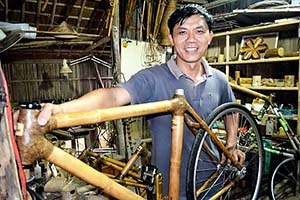 Bamboo Bikes
Bamboo Bikes
Vo Tan Tan is one of Hoi An's more fascinating craftsmen. An engineer, Vo is making biking even more eco-friendly making custom, hand-made bikes, mostly from bamboo. Vo's bikes are premium frames, made for European and Australian clients costing from 10-40 million dong (US$446-$1,786), with special customized ones costing over $4,500. Tan makes around 50 of his unique bikes a year. During a visit, we'll learn about Vo's special eco-friendly craft and philosophy.
Ancient Ceramics
During the 15th century, off the Hoi An coast of Vietnam in the South China Sea, a trading vessel filled with porcelain vanished without a trace. Five hundred years later, in 1999, archaeological excavation bought the collection back up. Altogether 244,000 artifacts were retrieved, with a miraculous 150,000 of these pieces still intact. A subsequent Butterfield auction event grossed more than $2.8 million, and represented the largest consignment from a single source ever handled by the firm’s Asian art department.
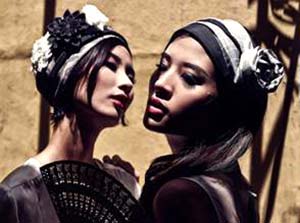 FLORENCE MUSSOU
FLORENCE MUSSOU
Visit with the co-founder of high-end fashion shops in Hanoi, Saigon, and Hoi An (here or in Saigon by availability), Metiseko is Florence’s latest project, featuring women’s clothing and home ware. Situated in the heart of the town, Ms. Mussou's creations are imbued with Hoi An’s silk traditions and Japanese, French and Chinese influences.
Meiseko follows environmentally-friendly manufacturing processes and utilizes only organic cottons by working with GOTS certified cotton producers, and 100% natural silk sourced from Vietnam’s highlands. Inspired by travels and Vietnamese iconic symbols, Florence and her designers merge the two by applying vibrant, colorful and chic designed prints on their fashion and home products. More at http://metiseko.com/
FLASH FASHION
What Hoi An tailors lack in quality (compared with those Bangkok and Hong Kong), it more than makes up with drama. "Flash fashion," the ability to create or duplicate clothes just overnight, is a feature and amusing experience of the town. The quality nor textiles are not on par with that found in Hong Kong or Bangkok, but the instant gratification and ability to duplicate a favored article of clothing with charming staff is part of the show or reason to have something made here. We will visit Yaly Couture, the largest, for a private tour of their large production space.

Activities
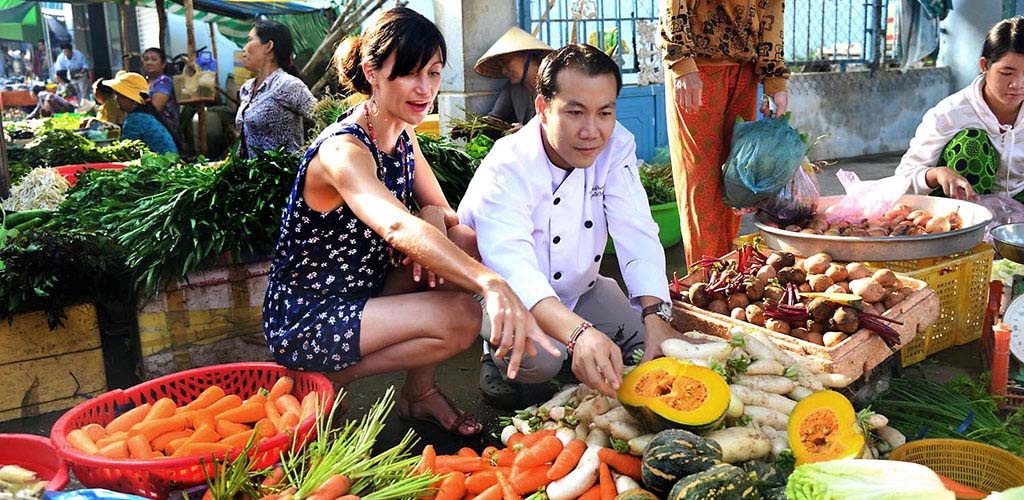
Cooking Class
What you may heave heard is correct—Hoi An has some of the best local dining in Vietnam. Unlock the secrets of Hoi An's cuisine with a half-day class which includes a market visit. Pleasant activities we can arrange are cycling out to Cua Dai Beach if the weather is sunny (about three miles, flat paved road) or half- to full-day cycling trips further afield, through local farms and villages. The Thu Bon River, fronting Hoi An provides a pleasant sunset cruise, after which we can stroll the town and take in the nightly events, such as live music. Nearby places you may read about, including My Son, Cham Museum in Danang, and Marble Mountain are, frankly, tourist traps and we recommend visiting only if you are in Hoi An for an extended stay.
Bicycling
We organized the very first bicycling tours of Vietnam in 1994 through our adventure wing VeloAsia (www.veloasia.com). Hoi An was always our favorite stop and where we usually lingered for a day or two longer. Cycling outside Hoi An through local farms, through villages, and along the coast remains a delight. We will load our bikes onto a small sampan (boat) to motor out of town then disembark and mount our bikes far from town on this half-day excursion. Explore the countryside on two wheels! After an early breakfast, meet your guide for short briefing, then clicking on your helmet and peddling through the countryside, bound for the village of Tra Que, an easy flat ride though country lanes and fields about an hour away.
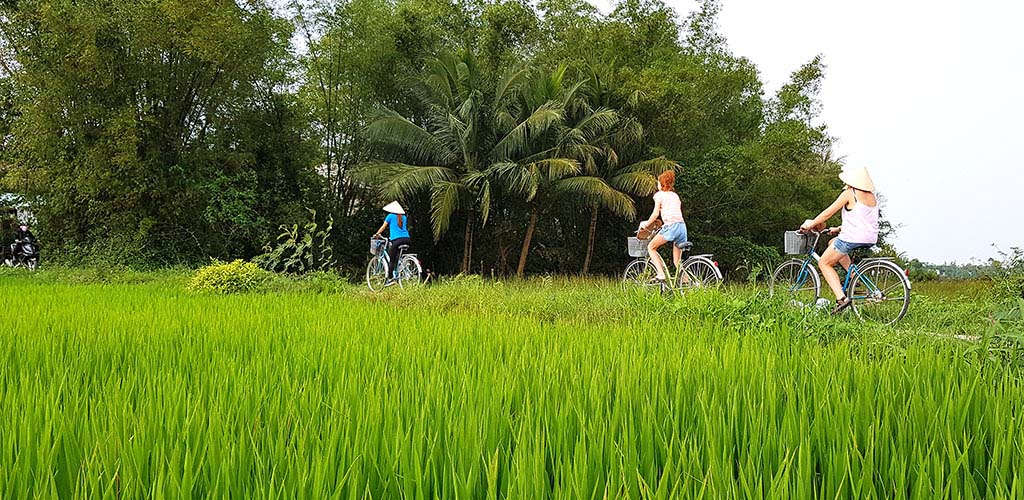
This village is known for its fresh local herbs and vegetables, and is named after the sweet smelling herb that is used to flavor many of Hoi An dishes, for locals insist on these herbs for the very best quality dish. The farmers here use no fertilizers in their soil, using instead, an algae found only in a lagoon adjacent to the village which produces abundant and tasty herbs and vegetables used to flavor dishes such as Banh Xeo, Cao Lau and My Quang. We'll tour the village, learning about producing crops such as red eye chili, lemongrass, basil, coriander and spring onions.
Tailoring
For tailoring, Hoi An is famous for "flash fashion," the ability to create or duplicate clothes overnight. The quality nor textiles are not on par with that found in Hong Kong or Bangkok, but the instant gratification and ability to duplicate a favored article of clothing is part of the show or reason to have something made here. Note: The textiles are not premium, but the overnight tailors real skill is duplicating garments you've brought from home or perhaps being fitted for a Vietnamese dress (Ao Dai). The best tailor - meaning fastest - is Ya Ly (which due its size is also the most reliable on delivery time). Let us arrange a private meeting with the founder who now employs over 250 workers in Hoi An.
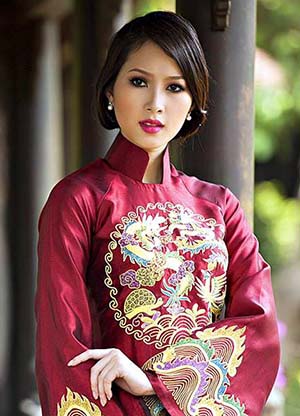 Ao Dai
Ao Dai
The ao dai is the ubiquitous traditional flowing dress you see school girls in, gliding gracefully by on their bicycles. These plain, white versions are for school but you may spy some of the colorful formal versions, beautifully and elaborately designed, and like the Japanese kimono, are custom designed and made by hand. Hoi An is the perfect place to have yours made, as turnaround is quit fast, in only a day or two.
Yoga & Meditation
Enjoy yoga at sunrise with Ms Van, a popular Yoga instructor in the area who will teach you the local expression of yoga.
Living History
Meet with local veteran in their home or important local government authority.
School Visit
Children's activities include visiting a local school to teach English, equally a delight for local children and your own. We may also arrange to donate needed school supplies. Hoi An is wonderful place to enjoy a buffalo cart ride in the countryside or even ride a buffalo. Children can also learn how to make hands-on the signature adornment of Hoi An, lanterns at a crafts shop or learning traditional calligraphy from a master.
Cruising
Perhaps Hoi An's most pleasant activity is a sunset cruise along Thu Bon river to dinner, or enjoying dinner on your own private boat.
Buddhist Encounter
Visit a hidden, charming pagoda to meet with an elder monk and sharing a vegan lunch with him while you learn about his unique lifestyle.
Farm & Countryside Day trip
After Tra Que, continued biking through the countryside, passing coconut palms and shrimp farms until arriving at the home of a local fishing family. The family will host us on a cruise through the tranquil and lush canals, fringed by river palms, in the unique coracle boat. Local fisherman can be spied, dredging the river bed in search of snails. After our coracle cruise, boarding our small sampan (boat) to cruise to another local village where our hosts, a family, have prepared a delicious lunch for us to share with them. After lunch, strolling around the village to observe manufacture of fishing nets that are so important to this community, basket boat makers and an ice works and crafts such as mat products and weaving, and also learning about everyday life and customs of the villagers. Here also visiting the “Bamboo House” built by a bamboo craftsman, where we can witness the traditional art of bamboo furniture making, a trade have been handed down through the generations. We will also spot boat building yards, wood carving workshops (where everything from furniture to ornate statues are made), and brickworks factories (between March and September). In the mid-afternoon, return to our boat and continue cruising along the river, busy with bird life and local fishermen who will be preparing for the night’s fishing. This hive of fascinating activity provides wonderful photo opportunities. After docking, return to Hoi An hotel, ending late afternoon.
Snorkeling
We may arrange all-day excursions off the coast of Hoi An where there are excellent scuba diving and snorkeling spots, with hundreds of different varieties of coral and tropical fish thriving in the warm tropical waters. Options include the Cu Lao Cham Marine Park (only 12 miles from Hoi An) offering eight islands teeming with marine life, the most interesting of which is Cham Island (below). Note: February through April are the warmest and driest months of the year for diving.

Hoi An's Culinary Tradition
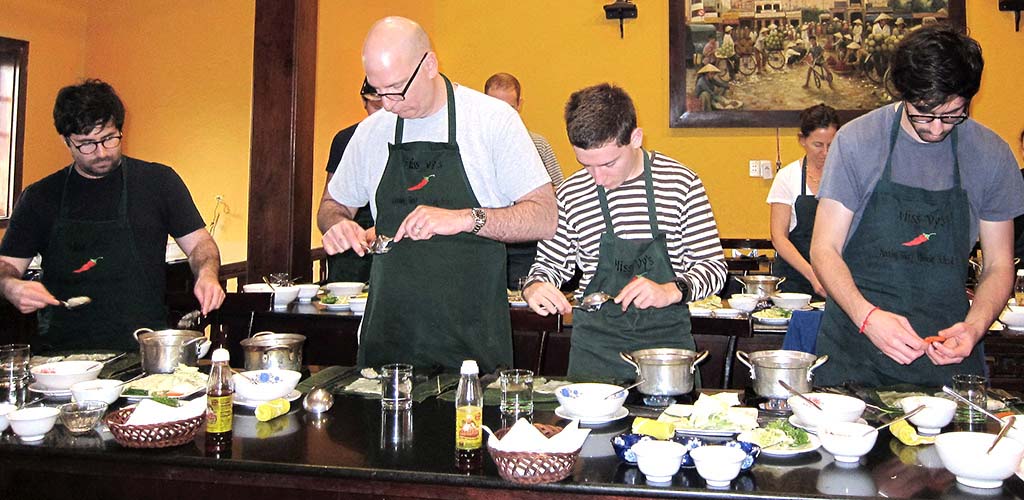
According to Los Angeles culinary Grand Wizard and Iron Chef Champion, Redbird's Neal Fraser, who has also lead our annual and semi annual culinary trips since the mid-1990s (See Iron Chef Asia), there is no better cuisine in the world than Vietnamese. And in Hoi An, you will discover why he feels that way.
With our architecture touring almost complete, its time to explore Hoi An's other treasures, including its fabulous cuisine and shops, featuring a talented tailoring community. Hoi An has excellent cuisine with several outstanding restaurants. Try local standout dishes, cao lau, a pork soup, and banh bao banh vac ("white rose"), a rice flour dumpling with shrimp filling.
Miss Vy, our very old friend, operates a delightful yet vigorous cooking class at her Vy's Marketplace, one of eight eateries she manages in Hoi An. Along with a market tour, her staff will teach you create several Vietnamese favorites, including spring rolls, green papaya salad, and banh xeo (crepe).For dining recommendations, please see below or our current restaurant list included in your trip materials.
Hoi An food walk: Enjoy this half-day tour of markets and local chefs to watch them prepare Hoi An specialties such as cao lau noodle and white rose, and learn hands-on preparing our own. We can also arrange touring of local farms to learn about crops and cultivation in the area, meeting with farmers and their families.
Cycling or by scooter to visit the busy dawn fish market where fisherman arrive into after a night on the water. We'll board a boat to meet with fishermen and view their catch and also meet with a buyer coming to this wholesale market to buy their fresh catch of the day to resell in Hoi An market.
We can organize a clam bake and BBQ on Cua Dai beach if the weather is favorable, beginning with a leisurely bicycle tour through villages on the way.
Hoi An Restaurants & Cafes
A few recommended dining venues are mentioned below, though An updated dining list and arrangements will be made before your departure.
Dao Tien
With a picturesque riverfront setting surrounded by lush tropical garden, Dao Tien offers contemporary and classical Hoi An gastronomy.
Cargo Club
A lively, in-town favorite founded by Hoi An's seminal chef Miss Trinh Diem Vy. Hoi An favorites, including cao lau pork soup and white rose (won tons) taste wonderful here. We recommend reserving a balcony table. The restaurant is also the site of Miss Vy's rigorous 1/2 day cooking class. Ask us to reserve a private lesson.
The Nam Hai
The Nam Hai resident venues are convenient, saving the 30-minute drive into town."The Restaurant" offers formal dining of an international menu of contemporary fusion, authentic Indian and grilled gourmet fare. "The Beach Resort" offers an informal setting on the palm-fringed swimming pool fronting Ha My Beach. The open air café serves up a global array of comfort foods throughout the day including thin sizzling pizzas, juicy burgers, copious salads and our neighbors, the fishermen’s freshest catch. When the sun sets, Vietnamese traditional musician accompany local delicacies like Cao Lau Hoi An, a steaming rice noodle soup with chillies and succulent pork.
The Nam Hai can also arrange a special private BBQ dinner for two on the beach.

Hoi An Accommodation
Where to stay during your time in Hoi An should abe decided by time of year and whether to stay several miles outside of town along the desolate white sands of Cua Dai beach at the renowned Four Season's Nam Hai, Indochina's premier beach resort, or within town itself for convenience of walking to the town's many attractions. If your travel is during the cooler season, we do recommend staying within town when the Nam Hai may not be enjoying ideal beach weather.
The Four Season's Nam Hai
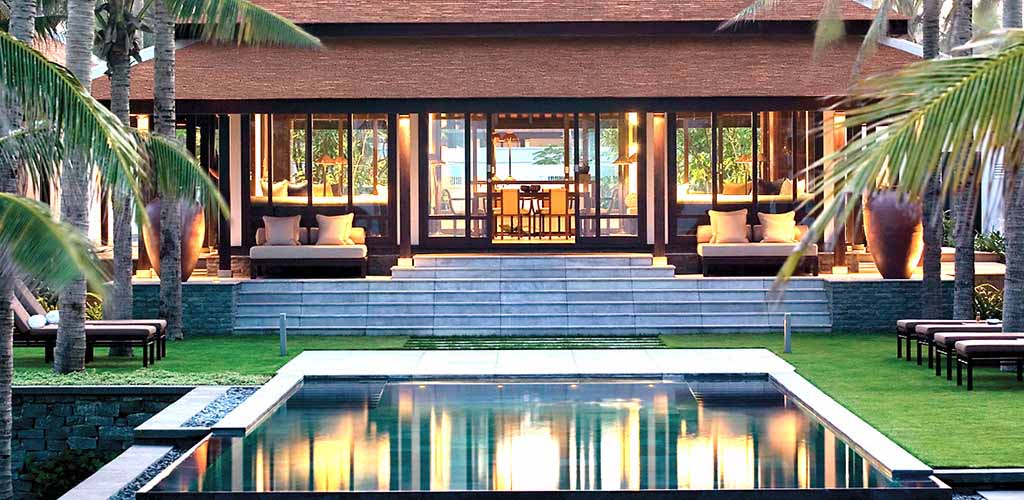
Indochina's premier beach resort. During better weather, the Nam Hai and Song Saa off Southern Cambodia offer sumptuous alternatives to traveling further south to the crowded Thai islands. The Nam Hai's beach remains largely empty, even during the high season and massive infinity pool (arguably one of the best swimming pools in the world) provides a refreshing dip.
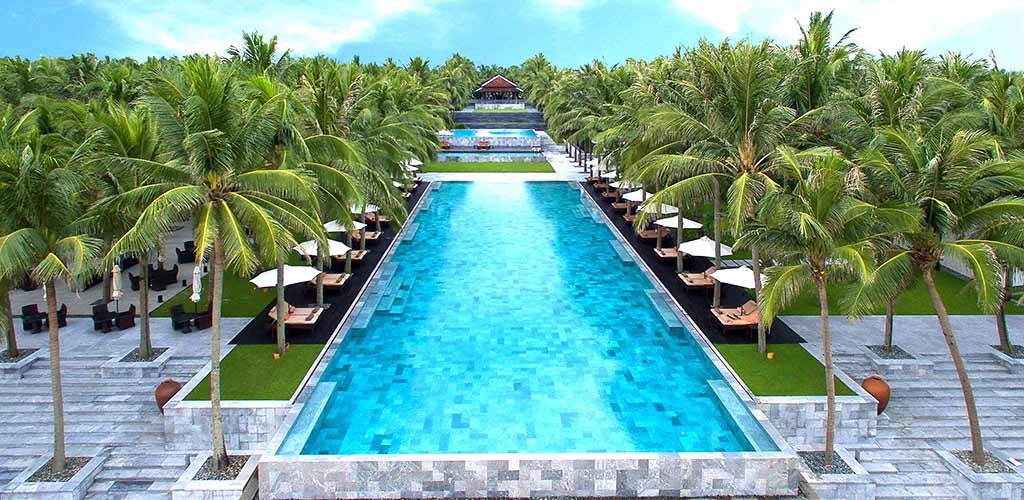
Spacious, the Nam Hai offers seclusion yet a very rare location for a resort, a mere 20 minutes away from a UNESCO World Heritage site, Hoi An, and its cultural riches. Contact us for the best time to visit and activities around the area.
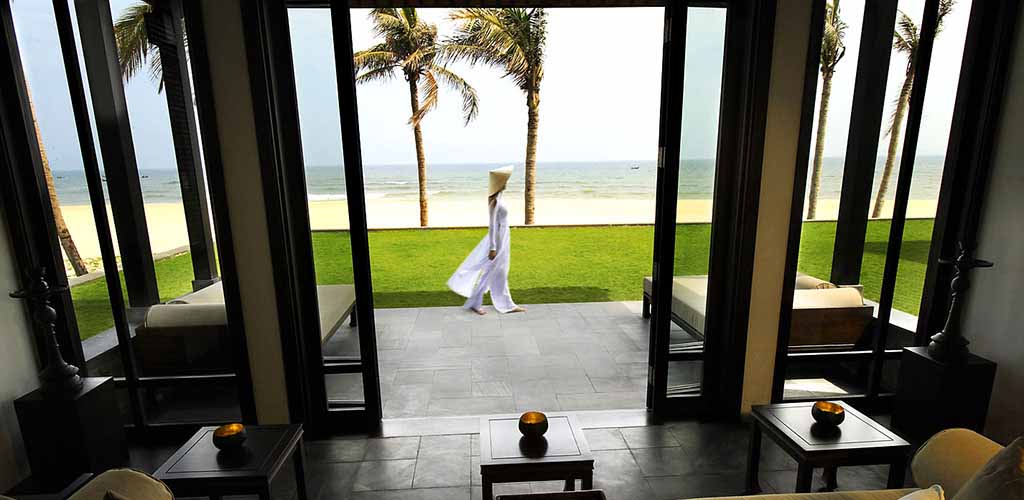
When to go
During the cool season, November through mid-February, it's better to stay in town rather the beach resorts on the coast where the weather will likely be overcast will drizzle and wind. Dry months are March through September. For beach time, the best months are March through September although it is very hot in July. Transitional February can can be sunny or overcast.

